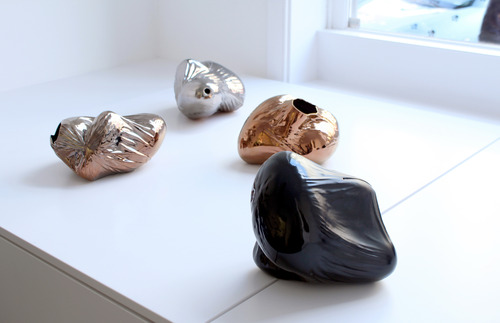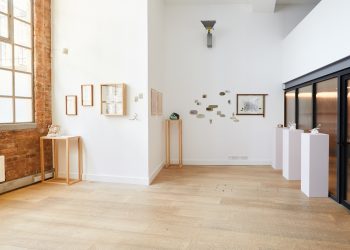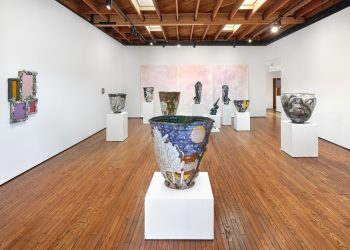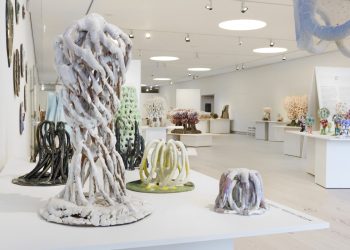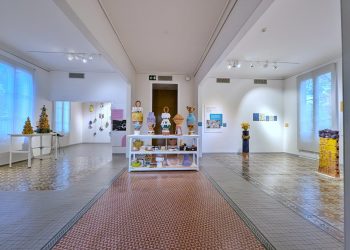Caroline Andrin and Francois Ruegg / Puls Ceramics, Brussels
October 13 – November 17, 2012

Caroline Andrin
Swiss ceramist Caroline Andrin maintains her studio in Brussels as well as holding the Ceramics Department chair at La Cambre. Widely traveled and exhibited, this is her second Puls exhibition. Andrin has entitled this series of work Skin Game.
Much of Andrin’s art has been inspired by the examination of the intimate relationship that we have with the objects in our everyday environment, objects that we wear or use. Throughout her career, Andrin’s work has developed from one object to the next, sometimes by taking into consideration the function of the original object and sometimes by a larger context. She has been inspired by the principle that every form hides another form within it and that through a process of her own using clay, both the inside and the outside of an object can be made visible.
The title of this series is particularly apt. It asks many questions. Skin: what is it, when and where do we encounter it, and what deeper consequences does it hold for us as individuals and our values. We seldom pause to remember that the skin of a mammal—and specifically humans—is the largest organ in the body. As for game, is it the mere entertainment of stalking and bringing back a trophy to hang on a wall or the hides that kept our prehistoric ancestors alive through the Ice Ages?
The series consists of an ensemble of Trophies and Accessories. Game here of course assumes its double meaning, referring to play as well as hunting.
Andrin pits our visual perception against our sense of touch. She has captured the visual qualities of skin and then assaults the innate coordination of our sense with entirely the wrong texture. The work certainly has the look but not feel. She is challenging the very essence of the materiality we expect.
Each Trophy originates from a pair of leather gloves. The gloves are turned inside out, cut up and sewn back together in order to make a mold into which clay is poured. This process involves the casting of clay slip. Traditionally clay is cast in plaster molds. Since 1996 however, she has used material for molds that leave a trace on the final object. This is a verification of the idea that one form contains another.
The manipulation of the original object (the leather glove) creates an imaginary bestiary which speaks of the skin. Andrin examines our emotional relationship with objects and in this case, all that the objects represent.

Francois Ruegg
Francois Ruegg is an award winning Swiss ceramist exhibited at Puls for the first time. Ruegg intentionally uses allegory to color the figurative presence of his objects and their complex allusions. He plays with our innermost expectations, our stereotypes, and sends us on strange trains of thought. Ruegg deliberately leads us astray as he challenges our internalized landmarks and creates confusion in our perceptions. This is work that provokes, destabilizes, and opens up only enough to give up a few clues to understanding.
The porcelain sculptures in this series all begin with a carefully selected melon or eggplant, chosen for its highly evocative ambiguity. Ruegg wraps each in a thin plastic sheet which is then stretched to its limit. This covering puts a veil over the still life and creates an often profound disturbance which in turn unveils something seemingly—or perhaps only possibly—unnatural. He then uses the resulting modeling to makes a mold in which to cast an object that will corroborate the idea he wishes to declare.
The openings and cuts establish a purely visual relationship between the inner and outer faces of the form while at the same time luring our gaze with their troubling likeness. In fact, they present themselves as real bruises or red openings of sensuality and eroticism. The tactile aspect of the volumes—black to evoke the latex and leather universe, metallic to escape our expectation of white porcelain and reinforce the artificiality of pretense, or matte, smooth or lustrous, to increase the desire to touch, caress, feel their lasciviousness—all add to the duality of the perception.
The resulting ceramics—parts of which are a direct imprint bursting with reality—then assert their intention with humor and relevance. His has intentionally made these pieces to be objects able to be read equivocally. Ruegg plays with our perception, giving us simultaneously a double reference to the original natural forms while eliciting imprinted iconic temptations. The real nature (the truth?) nevertheless remains open to doubt. The viewer’s initial impressions of something rather vegetable-like are immediately confused by more erotic interpretations. Indeed, these ceramics have as much of a resemblance to packaged melons and eggplants as to genitals bound in a smooth and sensual material.
Gallery hours: Wednesday to Saturday, 13.00 – 18.00.
CONTACT
Annette Sloth
mail@pulsceramics.com
Tel: +32 494 83 60 55
Puls Contemporary Ceramics
Edelknaapstraat 19 rue du Page (Châtelain)
B-1050 Brussels
Belgium
www.pulsceramics.com
Above:
(first image) Caroline Andrin, Skin Game, 2012, Earthenware, Slip, Variable dimensions.
(second image) Francois Ruegg, Contre nature morte, 2012, Porcelain, Luster.


